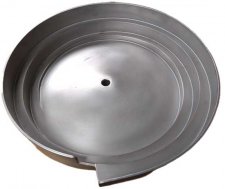Vibratory Feeder Bowl Basics: Choosing the right bowl for your part
A vibratory feeder bowl is an integral part of an industrial automation system but what makes a specific bowl fit a particular part application?
When choosing a feeder bowl to orient your part, the first factor in making your decision should be the part size. The bigger the part, the bigger the bowl should be to accommodate the orienting process. A general rule is that the bowl should be 10 to 15 times the size of the part. For example, if you have a part that measures two inches then you would choose a bowl that is at least twenty inches in diameter.
The next step in the decision-making process is to determine the rate at which you would like your parts to feed into the rest of the assembly process. Feed rate is expressed in Parts Per Minute (PPM) and depends on many factors including the configuration and mass of the parts, the amount of orientation needed and the number of tracks in the bowl. If you would like a higher feed rate you should choose a larger bowl size. Using the 2-inch part from above, the initial calculation was for at least a 20-inch diameter bowl but to increase PPM you would need to increase the bowl diameter.
Now that you have an idea of the feeder bowl size, you must choose the bowl material that is best suited to move the part. There are a couple of materials commonly used in bowl construction: stainless steel and cast aluminum The part geometry (shape) determines the best material to use in choosing a bowl for your part orienting application. If the part is a simple shape (ex: round, rectangular), then the best choice would be a cast aluminum bowl, however if the part has a more complex geometry, then you would opt for a stainless-steel bowl.
Part Geometry isn’t the only factor in determining which type of bowl to use. Choosing the proper bowl material also depends on the makeup of the part. If the part is plastic or composed of softer elements, then a cast aluminum bowl would work for your application but if the part is hard or abrasive then a stainless-steel bowl would be necessary for optimum system performance
Further consideration should also be given as to the intricacy of the part orientation. If the part needs to escape the bowl in a specific manner, the fabrication flexibility of a stainless-steel bowl would best suit the application, but if the positioning of the part is not a factor, then a cast aluminum bowl would work.
These are just the first steps in figuring out which vibratory feeder bowl would be right for your part orienting needs. For further assistance in assembling your automation system our experienced, professional staff at Automation Devices can help you through the entire process. We have the components and knowledge to design a system for any application and any environment. Contact us by phone at 814-474-5561 or online anytime at www.autodev.com


